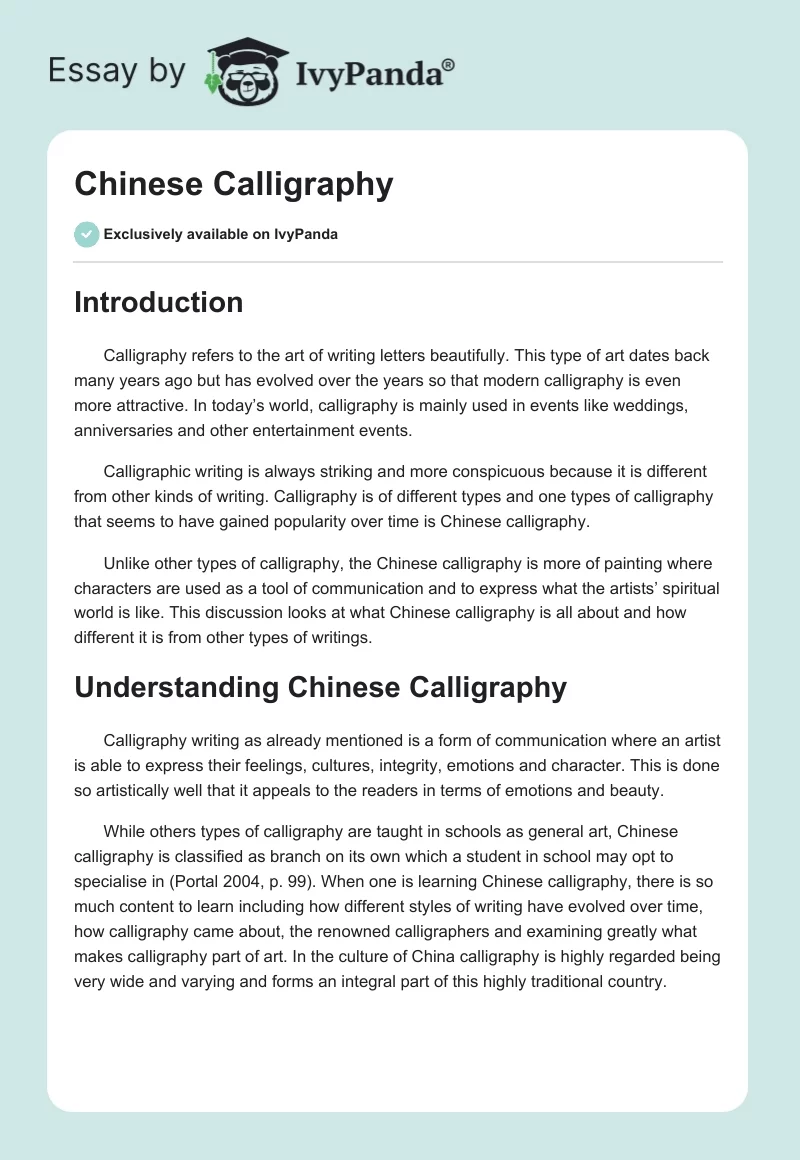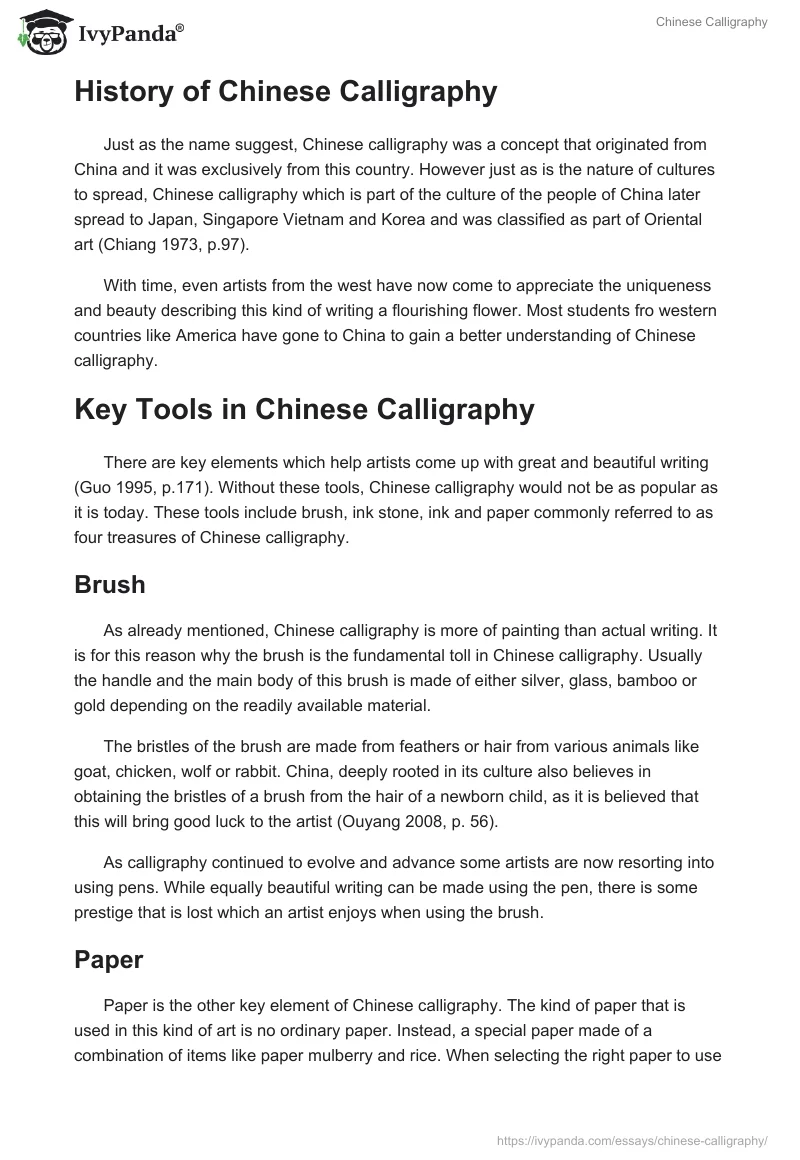Introduction
Calligraphy refers to the art of writing letters beautifully. This type of art dates back many years ago but has evolved over the years so that modern calligraphy is even more attractive. In today’s world, calligraphy is mainly used in events like weddings, anniversaries and other entertainment events.
Calligraphic writing is always striking and more conspicuous because it is different from other kinds of writing. Calligraphy is of different types and one types of calligraphy that seems to have gained popularity over time is Chinese calligraphy.
Unlike other types of calligraphy, the Chinese calligraphy is more of painting where characters are used as a tool of communication and to express what the artists’ spiritual world is like. This discussion looks at what Chinese calligraphy is all about and how different it is from other types of writings.
Understanding Chinese Calligraphy
Calligraphy writing as already mentioned is a form of communication where an artist is able to express their feelings, cultures, integrity, emotions and character. This is done so artistically well that it appeals to the readers in terms of emotions and beauty.
While others types of calligraphy are taught in schools as general art, Chinese calligraphy is classified as branch on its own which a student in school may opt to specialise in (Portal 2004, p. 99). When one is learning Chinese calligraphy, there is so much content to learn including how different styles of writing have evolved over time, how calligraphy came about, the renowned calligraphers and examining greatly what makes calligraphy part of art. In the culture of China calligraphy is highly regarded being very wide and varying and forms an integral part of this highly traditional country.
History of Chinese Calligraphy
Just as the name suggest, Chinese calligraphy was a concept that originated from China and it was exclusively from this country. However just as is the nature of cultures to spread, Chinese calligraphy which is part of the culture of the people of China later spread to Japan, Singapore Vietnam and Korea and was classified as part of Oriental art (Chiang 1973, p.97).
With time, even artists from the west have now come to appreciate the uniqueness and beauty describing this kind of writing a flourishing flower. Most students fro western countries like America have gone to China to gain a better understanding of Chinese calligraphy.
Key Tools in Chinese Calligraphy
There are key elements which help artists come up with great and beautiful writing (Guo 1995, p.171). Without these tools, Chinese calligraphy would not be as popular as it is today. These tools include brush, ink stone, ink and paper commonly referred to as four treasures of Chinese calligraphy.
Brush
As already mentioned, Chinese calligraphy is more of painting than actual writing. It is for this reason why the brush is the fundamental toll in Chinese calligraphy. Usually the handle and the main body of this brush is made of either silver, glass, bamboo or gold depending on the readily available material.
The bristles of the brush are made from feathers or hair from various animals like goat, chicken, wolf or rabbit. China, deeply rooted in its culture also believes in obtaining the bristles of a brush from the hair of a newborn child, as it is believed that this will bring good luck to the artist (Ouyang 2008, p. 56).
As calligraphy continued to evolve and advance some artists are now resorting into using pens. While equally beautiful writing can be made using the pen, there is some prestige that is lost which an artist enjoys when using the brush.
Paper
Paper is the other key element of Chinese calligraphy. The kind of paper that is used in this kind of art is no ordinary paper. Instead, a special paper made of a combination of items like paper mulberry and rice. When selecting the right paper to use in Chinese calligraphy, it is important to also get a paperweight which is used to ensure that paper is held down firmly when the writing is being done. Paperweights also prevent the paper from slipping and sliding when the artwork is being done. Paperweights are of different types and the kind of paperweight chosen will be dependent on the kind of paper that is being used.
Desk pads
Desk pads are equally important in Chinese calligraphy. The pad has a grid on each side and is normally placed under a paper which is translucent. The pad therefore acts as a guide to the artist and ensures that the artist in accurate when placing the characters and that their sizes are in order. Desk pads are mainly used be people who are still in the learning process, but for an artist who has mastered well the art of Chinese calligraphy, the desk pads are not necessary.
Ink
Ink also forms an integral part of Chinese calligraphy. The ink used in this artistic writing is made from soot from a lamp together with binders. This ink is put in what is known as ink sticks and before it can be used, the ink sticks must be rubbed against ink stone using water (Long 2001, p.71). This is an essential procedure which is used to ensure that ink has the required consistency needed for good results to be achieved. Today, instead of having to go through lengthy procedure, artists are now going for inks that have already been mixed and having the right consistency they are put in bottles (Chiang 1973, p.198). Since the ones contained in bottles have some chemicals that have been used for purposes of preservation, ink sticks are more preferred as they are of higher quality and are more durable than the bottled inks. While bottled inks are an easy option for many artists, those who are still learning are encouraged to use stick so that they can master the art of mixing inks and achieving the correct consistency. Back when Chinese calligraphy was started, artists would only use black ink, however with time artists are beginning to incorporate other colors making the writing even more attractive.
Ink stone
Ink stone is a hard substance which could either be clay, stone or ceramic used for purposes of helping disintegrate the ink stick and grind it to become ink in liquid form which is the used for calligraphy. In China, ink stones are very expensive as they have become very popular yet they are very rare to find.
The Seal
Once an artist has finished his calligraphic work, the last thing to do is to put a seal which is done using an ink that is red in color. This is an official signature of the artist to show that a certain piece of work belongs to him. As Chinese calligraphy continues to advance, it is becoming increasingly popular in America and other countries of the west with artists from this region beginning to appreciate the uniqueness and beauty of Chinese calligraphy (Chiang 1973, p.67). Most artists have been going to China to study this type of calligraphy in greater details
Principles of Chinese Calligraphy
The end results of Chinese calligraphy are determined by a number of factors. The first factor is the brush that you are using. Every aspect of the brush plays a key role on determining the end results. The size, shape and the kind of bristles on the brush determine how the image will be like.
The concentration or density of the ink as well as the colour used also contributes to the final results of calligraphy (Chen 2011, p. 356). Other techniques that artists use to influence the final results include the amount water and ink that he allows to be absorbed by the brush and the pressure that he used when writing. The direction of the brushing normally determines the size of the strokes with some coming out as bold while others are thin.
Determining Good Calligraphy
It is said that beauty is in the eyes of the beholder. This is the same case when it comes to calligraphy so that how nice the writing looks varies with different readers. There are however basic standards must be maintained for an artist to be said to have come up with good calligraphy.
To begin with, all characters must be written in a manner that is deemed correct by all calligraphers Legibility is another important aspect so that all writings must be readable. The writing must be concise with ink being the acceptable colour in Chinese calligraphy
References
Chen, T. (2011) Chinese Calligraphy. London: Cambridge University Press
Chiang, Y. (1973) Chinese Calligraphy: An Introduction to its Aesthetic and Technique. New York: Harvard University Press
Guo, B. (1995) Gate to Chinese Calligraphy. Beijing: Foreign Languages Press.
Long, J. (2001) The Art of Chinese Calligraphy. London: Courier Dover Publications
Ouyang, Z. (2008) Chinese Calligraphy. California: Yale University Press
Portal, J. (2004) Chinese Calligraphy: Standard Scripts for Beginners. London: Art Media Resources.


